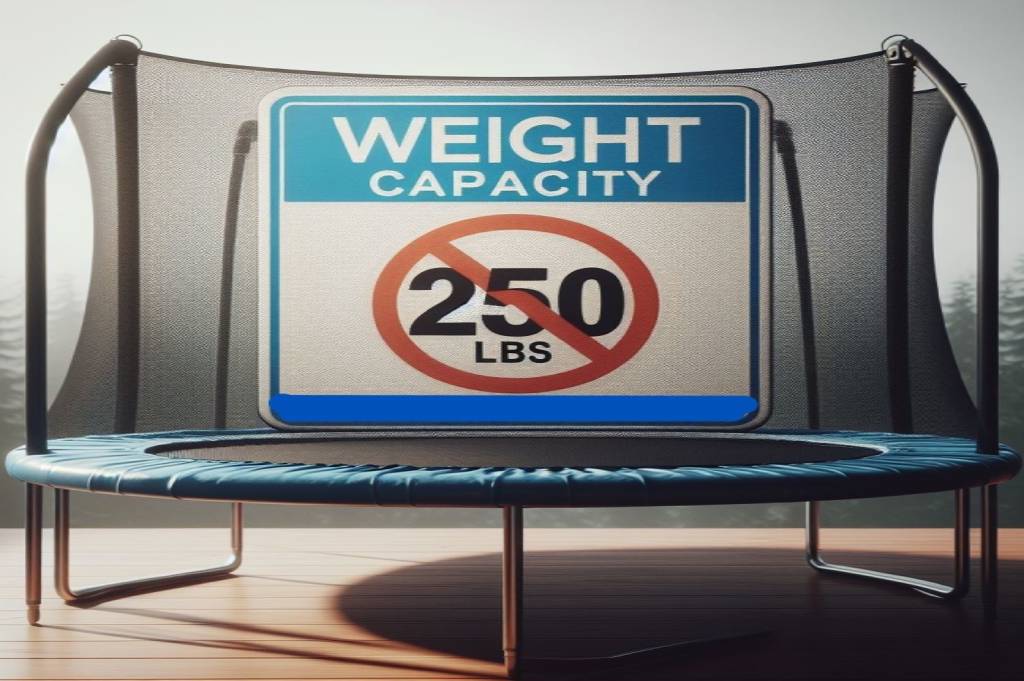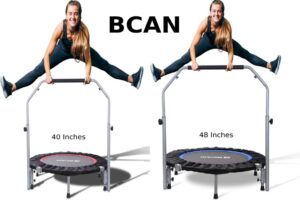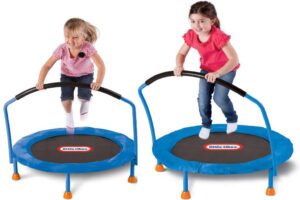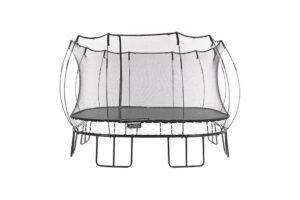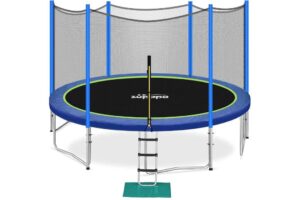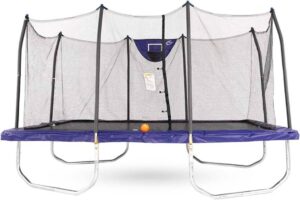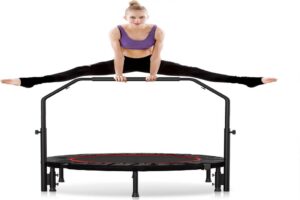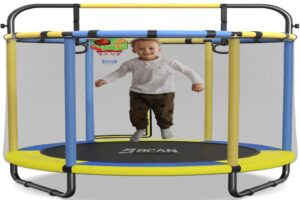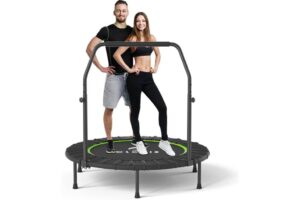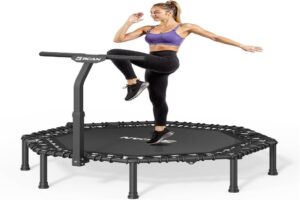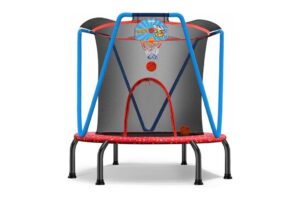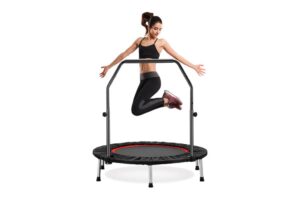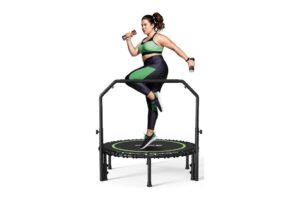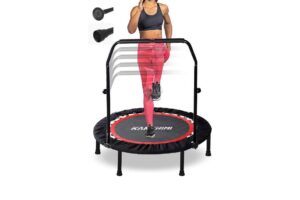Introduction
When it comes to trampoline safety and ensuring fun and injury-free jumping sessions, understanding the trampoline weight limit is paramount. This guide aims to provide a detailed exploration of trampoline weight limits, their importance, and the factors that influence them.
Whether you are a parent planning to buy a backyard trampoline or a fitness enthusiast considering a rebounder, knowing the weight capacities and how they impact the trampoline’s performance and longevity is crucial. The trampoline weight limit is not just a number; it’s a crucial safety measure that ensures the durability of your trampoline and the safety of its users.
Definition of Trampoline Weight Limit
The trampoline weight limit refers to the maximum amount of weight a trampoline can safely support without risking damage to the structure or harm to the users. This limit includes not just the weight of a single individual but the combined weight of all users on the trampoline at any one time.
It’s important to recognize that exceeding this limit can lead to a higher risk of injuries and significantly reduce the lifespan of the trampoline. Manufacturers determine the trampoline weight limit based on various factors including the quality of materials used (such as springs, mat, and frame), the design and engineering of the product, and safety tests conducted during the development phase.
Importance of Trampoline Weight Limit
Adhering to the trampoline weight limit is essential for several reasons:
- Safety: This is the most critical factor. Overloading a trampoline can result in catastrophic failures, breaking springs, tearing the jumping mat, or collapsing the frame, which can lead to severe injuries.
- Durability: Consistently using a trampoline within its specified weight limit ensures that the trampoline remains in good condition over time. Overburdening the trampoline accelerates wear and tear on all components, potentially leading to expensive repairs or replacements.
- Performance: The trampoline weight limit also impacts the performance of the trampoline. A well-used trampoline within its weight capacity will provide optimal bounce and a safer experience. Exceeding the weight limit can alter the mechanics of bouncing, reducing the effectiveness and fun of using the trampoline.
Understanding and respecting the trampoline weight limit ensures that every jump remains safe and enjoyable, and keeps the trampoline functioning properly for as long as possible.
Regulatory Standards and Safety Certifications
Trampoline weight limits are not arbitrarily set. They follow specific regulatory standards and safety certifications to ensure every user’s safety:
- ASTM International: Formerly known as the American Society for Testing and Materials, ASTM sets global standards, including those for trampolines. ASTM F381-16 is the standard safety specification for components, assembly, use, and labeling of consumer trampolines.
- EN 71: This is a European Standard that specifies safety requirements for toys, including trampolines intended for children.
- TÜV Certification: A product with TÜV certification has been tested and approved for safety and quality by one of the most respected certification organizations in the world.
- GS Mark: The Geprüfte Sicherheit (GS) mark is a German safety mark indicating that a product has met high European safety standards.
These certifications are designed to protect users by ensuring that trampolines meet rigorous safety and quality benchmarks before they reach the consumer. Manufacturers undergo these certification processes to prove their commitment to safety and to distinguish their products in the market.
By adhering to these standards, trampoline manufacturers not only ensure the safety and satisfaction of their customers but also contribute to the overall reliability and trustworthiness of their products. As a consumer, looking for these certifications when purchasing a trampoline can provide assurance that the product meets established safety criteria, and that the trampoline weight limit stated has been thoroughly tested and verified.
Factors Influencing Trampoline Weight Limit
The safety and functionality of a trampoline are largely dependent on its weight capacity, which can be influenced by several critical factors. Understanding these factors can help you choose the right trampoline that suits your needs while ensuring safety and longevity. Here, we delve into the materials, design, and size considerations that affect a trampoline’s weight limit.
1. Material Quality
-
Springs
The springs of a trampoline are pivotal in determining its weight limit. High-quality springs are made from galvanized steel, which provides strength and resistance to stretching underweight. The length and number of springs also play crucial roles; more numerous and longer springs distribute the force exerted by users more effectively, thus supporting more weight and enhancing the bounce quality.
-
Mat
The jumping mat significantly impacts the trampoline weight limit. Durable mats are typically crafted from woven polypropylene or waterproof canvas, materials chosen for their ability to withstand intense force without tearing. The mat’s integration with the rest of the trampoline through stitching and V-rings must be robust enough to handle the maximum stress from the combined weight of multiple users.
-
Frame
The frame supports the entire structure of the trampoline and directly influences its weight capacity. A sturdy frame made from heavy-gauge steel will ensure the trampoline can handle higher weights. The frame’s stability is enhanced by the quality of the joints and the assembly technique used, which prevents structural twisting and bending under load.
2. Design and Construction
The design and construction of a trampoline are fundamental in determining its weight limit. Engineering plays a crucial role in this aspect, where ergonomics, structural integrity, and safety converge to create a product suitable for both intensive use and optimal performance.
- Engineering Quality: Engineers design trampolines by calculating load distributions, potential stress points, and optimal material placements. This meticulous planning ensures that every jump is supported by a well-balanced force distribution, minimizing wear and tear and maximizing the trampoline’s lifespan.
- Safety Features: Additional design features such as safety enclosures, padded edges, and spring covers are integrated not only for safety but also to support the structural components, helping to distribute the user’s weight evenly across the trampoline.
3. Size and Shape
- Size: Generally, larger trampolines have higher trampoline weight limits. This is because they have more surface area to distribute weight, allowing them to accommodate more users simultaneously. However, the size must be complemented by the appropriate number of springs and a robust frame to truly benefit from the increased weight capacity.
- Shape: The shape of a trampoline affects how weight is distributed across the surface. Round trampolines distribute weight evenly around the edge and are suitable for lighter or fewer users. Rectangular trampolines, however, provide a stronger bounce and typically support a higher weight limit due to their reinforced structure and the way they distribute force along the longer sides of the rectangle.
In conclusion, understanding these factors when shopping for a trampoline ensures that you select a product that not only fits your space and usage plans but also adheres to safety standards, thanks to its appropriate trampoline weight limit. By choosing a trampoline with a suitable weight capacity, you enhance user safety and extend the life of the trampoline.
Safety Implications of Trampoline Weight Limit
Understanding and adhering to the trampoline weight limit is not just about maintaining the longevity of your trampoline—it’s also a crucial safety protocol. Overloading a trampoline beyond its intended weight capacity can lead to accidents and injuries. Here, we will explore the risks of overloading, reflect on real-life incidents, and offer safety tips to ensure a fun and safe trampolining experience.
Risks of Overloading a Trampoline
Exceeding the trampoline weight limit can have severe consequences, affecting both the structural integrity of the trampoline and the safety of its users. Overloading can lead to:
- Frame Damage: The frame of the trampoline, designed to support a specific maximum weight, can warp, bend, or even break under excessive load. This compromises the trampoline’s stability and can lead to sudden collapses.
- Spring Failure: Springs that are over-stretched due to excessive weight can snap, causing sharp metal components to become hazardous projectiles and the mat to sag or tear unexpectedly.
- Mat Tear: Exceeding the trampoline weight limit increases the risk of the jumping mat tearing during use, which can result in falls that may cause serious injury.
Real-life Incidents
Several incidents highlight the dangers of ignoring trampoline weight limits. For example, there have been reported cases where trampoline frames have collapsed under the weight of too many users, leading to injuries like fractures and concussions.
These incidents serve as stark reminders of the importance of respecting the trampoline weight limit. Manufacturers often set these limits based on rigorous testing to ensure user safety and product durability.
Safety Tips for Trampoline Use
To ensure the safety of all users, it’s essential to follow these safety tips related to the trampoline weight limit:
- Check the Manufacturer’s Guidelines: Always refer to the manufacturer’s specifications for the trampoline weight limit and ensure all users are aware of these restrictions.
- Monitor Usage: Keep an eye on the number of people using the trampoline at one time. Even if individual weights are within limits, collective weight can quickly exceed safe bounds.
- Regular Maintenance: Regularly inspect the trampoline for any signs of wear and tear, especially on the springs, mat, and frame. Replace any worn or damaged parts immediately to maintain the safety and integrity of the trampoline.
- Educate Users: Teach users about the importance of the trampoline weight limit and the risks associated with overloading. Encourage safe jumping practices and enforce rules that prevent risky behaviors.
- Use Safety Gear: Equip your trampoline with safety accessories like nets and padding. These can prevent falls and injuries, particularly when accidental overloading occurs.
By understanding and adhering to the trampoline weight limit, you can prevent accidents and ensure a safe environment for everyone to enjoy the fun and benefits of trampolining.
Choosing the Right Trampoline
Selecting the right trampoline involves more than just size and price—it’s crucial to consider the trampoline weight limit to ensure safety and durability. Here, we will guide you through different trampoline styles and their weight capacities, how to understand weight limit specifications, and we will provide top picks of trampolines with the best weight capacity ratings.
Different Trampoline Styles and Their Weight Capacities
Trampolines come in various shapes and sizes, each with a different trampoline weight limit that caters to specific needs and spaces:
- Round Trampolines: These are the most common for backyard use. Their trampoline weight limits typically range from 200 to 450 pounds, making them suitable for children and adults alike. The circular design helps to naturally center jumpers, reducing the likelihood of falling off.
- Rectangular Trampolines: Preferred by gymnasts and those looking for higher performance, rectangular trampolines offer higher trampoline weight limits, generally from 300 to 550 pounds. Their shape allows for a more even distribution of force, resulting in a higher, more controlled bounce.
- Square Trampolines: Combining the benefits of round and rectangular shapes, square trampolines provide a large jumping area with trampoline weight limits typically between 250 and 500 pounds. They are excellent for multiple users at one time.
- Mini Trampolines (Rebounders): Designed for individual fitness routines, mini trampolines usually support weights from 200 to 400 pounds, depending on the model and build quality.
How to Understand Weight Limit
Understanding the trampoline weight limit is crucial for safety and maximizing the lifespan of your trampoline. Here’s how to read and interpret these specifications:
- Check the Manufacturer’s Label: All trampolines should have a clear label or manual stating their maximum weight capacity. This is the absolute limit that should not be exceeded to ensure safety and prevent damage.
- Consider the Users: Think about who will be using the trampoline. If multiple people are likely to jump simultaneously, you might want to opt for a trampoline with a higher weight capacity.
- Factor in Usage Frequency: More frequent use, especially by individuals close to the weight limit, may strain the trampoline more than occasional use by lighter individuals. Consider opting for trampolines with a higher weight limit for frequent use.
Trampolines with the Best Weight Capacity Ratings
After thorough research, here are some of the top picks for trampolines that offer excellent trampoline weight limits along with reliability and safety:
- Skywalker 15-Foot Jump N’ Dunk: With a trampoline weight limit of 375 pounds, this model is ideal for families looking for safety and fun. It includes a basketball hoop for added enjoyment. (Explore our detailed comprehensive review on Skywalker Trampolines Round Series here).
- AlleyOOP Power Bounce Rectangular Trampoline: This high-end model features a dual-spring setup that can be adjusted for performance and has a trampoline weight limit of up to 800 pounds, making it suitable for serious athletes or heavier users.
- Springfree Trampoline – 13ft Jumbo Square with Basketball Hoop & Ladder: Known for its safety, this model eliminates springs entirely and offers a trampoline weight limit of 330 pounds. It’s a great choice for active kids and adults.
Choosing the right trampoline according to the trampoline weight limit not only ensures safety but also enhances the overall jumping experience. Whether for fitness, competitive training, or backyard fun, selecting a trampoline that meets your specific needs in terms of weight capacity is essential.
Maintenance and Trampoline Weight Limit
Ensuring that your trampoline remains safe and functional over the years largely depends on regular maintenance and understanding the importance of the trampoline weight limit. Proper upkeep not only preserves the weight capacity but also extends the life of your trampoline. This section provides insights into routine checks, when to replace parts, and DIY tips to maximize the longevity of your trampoline.
Routine Checks to Preserve Weight Capacity
Regular maintenance checks are crucial to ensure the trampoline weight limit is maintained, preventing safety hazards and equipment failure. Here are some aspects to focus on:
- Spring Inspection: Springs are vital for maintaining the trampoline’s tension and bounce. Check for any loose, worn, or rusted springs and replace them as needed to maintain the trampoline’s weight limit.
- Mat and Net Examination: Inspect the jumping mat and safety net for any tears, holes, or deterioration. Any damage can significantly affect the trampoline’s weight limit and overall safety.
- Frame Check: Ensure the frame is not bent, broken, or rusted. Structural integrity is essential for supporting the stated trampoline weight limit.
- Cleaning: Regularly clean the mat, springs, and frame to remove dirt and debris that could wear down materials and compromise the trampoline’s weight limit.
When to Replace Parts to Maintain Optimal Weight Limit
Understanding when to replace parts of your trampoline is key to maintaining its optimal trampoline weight limit:
- Springs: Replace springs if you notice any loss of elasticity or if they appear stretched out, as this can affect the trampoline’s weight capacity and safety.
- Jumping Mat: If you see signs of fraying or hear unusual sounds while jumping, it’s time to consider a replacement to ensure the trampoline weight limit is not compromised.
- Safety Padding: Padding that covers the springs and frame can wear out and expose jumpers to injury risks. Replace them if they are no longer providing sufficient cushioning.
- Frame: Though less common, a frame may need to be replaced if it shows signs of severe rust or structural damage that could affect the trampoline weight limit.
DIY Tips for Increasing the Longevity of Your Trampoline
To enhance the durability of your trampoline and ensure it continuously meets its trampoline weight limit, consider the following DIY maintenance tips:
- Rust Prevention: Apply rust-protectant sprays on metal parts, especially if your trampoline is exposed to elements. This helps maintain the strength and integrity of the frame and springs, directly supporting the trampoline weight limit.
- Protective Covering: Use a weather-resistant cover to protect your trampoline when not in use, especially during adverse weather conditions. This can prevent premature wear and tear that might affect the trampoline weight limit.
- Proper Storage: During extreme weather, particularly in winter, consider dismantling and storing your trampoline indoors. This reduces the risk of damage from heavy snow or winds, preserving its trampoline weight limit.
By adhering to these maintenance tips, you can help ensure your trampoline remains safe, enjoyable, and within the recommended trampoline weight limit for years to come. Regular upkeep not only secures your investment but also guarantees countless hours of safe bouncing fun for the whole family.
Advanced Guides in Trampoline Weight Limit
As technology evolves and trampoline design continues to innovate, the understanding of trampoline weight limits becomes increasingly nuanced. Here, we will explore the latest technological advancements, the future of trampoline design, and expert opinions on trampoline weight limits.
Advancements and Their Impact on Weight Limit
Recent advancements in materials and engineering techniques have led to improvements in trampoline design and weight capacity:
- High-Tensile Springs: Manufacturers are utilizing high-tensile steel alloys to create springs with increased elasticity and durability. These springs can withstand higher loads without compromising on safety, thereby increasing the trampoline weight limit.
- Reinforced Frames: Innovations in frame design, such as double- or triple-gauge steel tubing and reinforced joints, enhance the structural integrity of trampolines. This results in higher weight capacities and improved safety for users.
- Advanced Mat Materials: The development of high-strength, UV-resistant materials for trampoline mats ensures longevity and reliability, even under heavy usage. These mats can support higher weight limits while maintaining optimal bounce performance.
The Future of Trampoline Design and Weight Capacity
Looking ahead, trampoline manufacturers are exploring new possibilities for enhancing weight capacity and safety:
- Smart Trampolines: Integrating sensor technology into trampoline frames and mats allows for real-time monitoring of weight distribution and stress levels. This data can help users stay within safe limits and alert them to potential risks of overloading.
- Modular Construction: Future trampolines may feature modular components that can be easily replaced or upgraded to accommodate changing weight requirements or user preferences. This flexibility ensures longevity and adaptability.
- Zero-Gravity Materials: Advancements in lightweight, ultra-durable materials may revolutionize trampoline design, allowing for higher weight capacities without sacrificing portability or bounce quality.
What Professionals Say about Trampoline Weight Limits
We reached out to industry experts to gather their insights on trampoline weight limits:
- Sarah Johnson, Trampoline Safety Specialist: “Trampoline weight limits are essential for ensuring user safety and preventing equipment failure. It’s crucial for manufacturers to conduct rigorous testing and adhere to industry standards to guarantee the reliability of their products.”
- James Smith, Structural Engineer: “From an engineering perspective, trampoline weight limits are determined by factors such as material strength, design geometry, and load distribution. As technology advances, we can expect to see even higher weight capacities and improved safety features.”
- Rebecca Miller, Fitness Instructor: “As a fitness professional, I emphasize the importance of respecting trampoline weight limits during workouts. Exceeding these limits not only increases the risk of injury but also compromises the effectiveness of exercise routines.”
In conclusion, technological advancements, innovative designs, and expert opinions continue to shape the understanding and application of trampoline weight limits. By staying informed and embracing these advancements, users can enjoy safer, more enjoyable trampolining experiences for years to come.
FAQ and Myths
Trampoline weight limits can sometimes be confusing or surrounded by misconceptions. Here, we address some common questions and debunk myths regarding trampoline weight limits.
FAQ
1. Is the Trampoline Weight Limit Per Person or Total?
One common question among trampoline users is whether the weight limit applies per person or in total. The answer depends on the manufacturer’s specifications, but generally:
- Per Person: Some trampolines specify a weight limit per person, meaning that multiple users can safely jump on the trampoline as long as their combined weight does not exceed the total weight limit. This information is usually clearly stated in the product manual or labeling.
- Total Weight Limit: Other trampolines provide a total weight limit for all users combined. Exceeding this limit can compromise the trampoline’s structural integrity and safety, regardless of the number of individuals jumping simultaneously.
2. Can You Exceed the Trampoline Weight Limit Safely?
Attempting to exceed the trampoline weight limit, even slightly, can have serious safety implications. Here’s why:
- Structural Integrity: Trampolines are designed to support a specific weight capacity based on factors such as material strength, frame construction, and spring tension. Exceeding this limit can lead to frame deformation, spring failure, or mat tearing, posing significant injury risks to users.
- Manufacturer Guidelines: Manufacturers rigorously test trampolines to determine their weight limits and ensure user safety. Ignoring these guidelines can void warranties and compromise liability in the event of accidents.
Debunking Myths
There are several myths surrounding trampoline weight limits that need to be debunked:
- Myth 1: Trampoline Weight Limits are Arbitrary: In reality, trampoline weight limits are carefully calculated based on engineering principles and safety standards. Manufacturers conduct extensive testing to determine the maximum weight capacity of their products.
- Myth 2: Higher Weight Limit Means Safer: While trampolines with higher weight limits may accommodate heavier users, safety ultimately depends on proper usage and adherence to guidelines. Even trampolines with high weight capacities can pose risks if used improperly.
- Myth 3: Weight Limit Doesn’t Matter for Kids: Children are often lighter than adults, but they can still exceed the weight limit when multiple kids jump together. It’s essential to monitor usage and ensure that children follow safety guidelines, regardless of their weight.
In conclusion, understanding the trampoline weight limit is crucial for ensuring user safety and maximizing the lifespan of the equipment. By adhering to manufacturer guidelines, debunking myths, and practicing proper trampoline safety measures, users can enjoy a safe and enjoyable bouncing experience.
User Experiences
Exploring real-life experiences and case studies can provide valuable insights into trampoline weight limits. Here, we’ll delve into stories from families, compare different brands, and gather feedback and advice from long-term trampoline users.
Stories from Families and Their Experiences
The Smith Family: The Smiths purchased a trampoline for their backyard, excited to enjoy hours of bouncing fun. However, they soon realized the importance of understanding the trampoline weight limit when inviting friends over for a group jump. By adhering to the weight limit and monitoring usage, they ensured a safe and enjoyable experience for all.
The Johnsons’ Dilemma: The Johnsons were unsure whether their trampoline’s weight limit applied per person or in total. After researching and consulting the manufacturer’s guidelines, they discovered that their trampoline had a total weight limit. This knowledge empowered them to enforce safety measures and prevent accidents.
Feedback from Long-term Trampoline Users
Jennifer’s Tip: “As a long-time trampoline owner, I’ve learned the importance of routine maintenance to preserve the weight limit. Regularly inspecting springs, mats, and frames ensures that the trampoline remains safe for my family and friends.”
Mark’s Insight: “Investing in a trampoline with a higher weight limit was worth it for us. With three active kids, we needed a trampoline that could accommodate their energetic play sessions without worrying about exceeding the weight limit.”
In conclusion, user experiences offer valuable lessons and insights into trampoline weight limits. By learning from others’ experiences, comparing different brands, and heeding the advice of long-term users, individuals can make informed decisions to ensure safety and enjoyment when using trampolines.
Conclusion
Trampoline weight limit are paramount for ensuring safety and enjoyment during bouncing adventures. Choosing a trampoline with an appropriate weight limit tailored to the intended users and their activities is crucial to prevent accidents and premature wear.
Now, trampoline weight limits aren’t just random numbers; they’re carefully decided by the folks who made the trampoline. They’ve done lots of testing to figure out what’s safe. So, it’s like following a treasure map—they guide you on your bouncing journey, making sure you stay out of trouble.
Adhering strictly to manufacturer guidelines, which are based on rigorous testing and safety standards, is essential to maintain structural integrity and user safety.
Regular maintenance, including thorough inspections of springs, mats, and frames, is vital for preserving the trampoline’s weight limit and extending its lifespan. By empowering oneself with knowledge about trampoline weight limits and implementing best practices for usage and maintenance, one can create a secure environment for endless hours of bouncing fun while minimizing risks of injury or equipment damage.
Even the sturdiest trampoline needs some love and care. It’s like having a pet—you’ve got to check on it regularly to make sure it’s okay.
In essence, prioritizing trampoline weight limit entails a multifaceted approach encompassing informed decision-making, adherence to safety protocols, and ongoing maintenance efforts.
So, let’s jump into fun safely together! Remember, following the rules and taking care of your trampoline means more smiles and laughter for everyone. Let’s bounce on!
Related posts:
- Trampoline Safety Tips – Jumping for Joy without the Risk
- Trampoline Assembly Excellence: Your Comprehensive Step-by-Step Guide to Bouncing Bliss!
- Trampoline Hole Repair Guide: Masterful Fixes for Unleashing Bouncing Power!
- The Ultimate Trampoline Measurements Guide: Elevate Your Bouncing Experience
- Indoor vs. Outdoor Trampolines: Dominate Your Bounce
